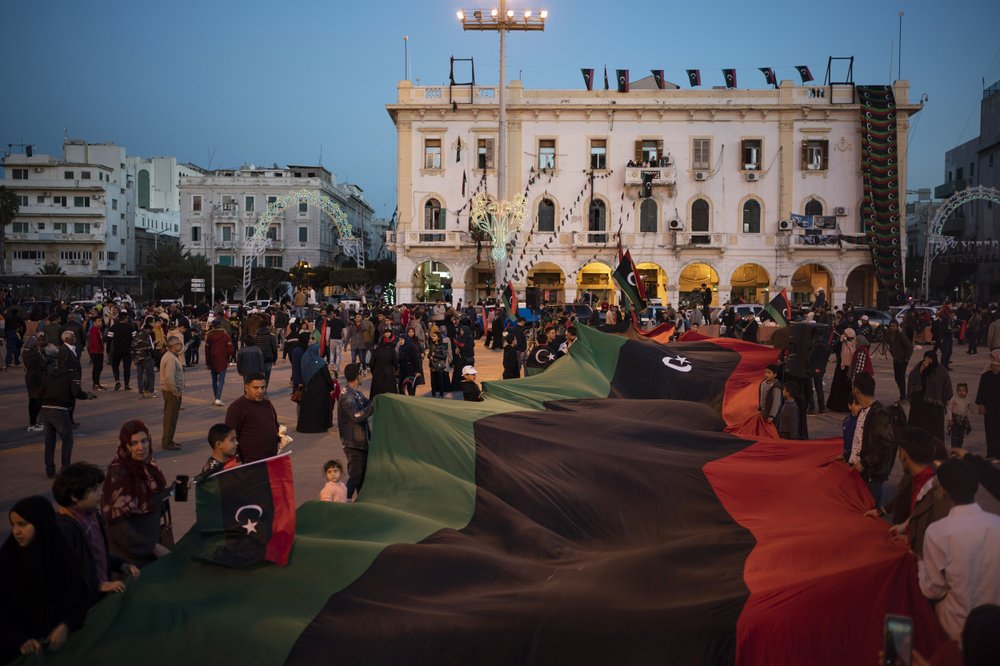Benghazi – In the chief stronghold of the Libyan revolutionaries, Benghazi authorities are converting former icons of Libyan leader Muammar Qadhafi’s brutal repression into vital tools of the new country they envision freed from despotic rule.
They’re not being discreet about it either. The president’s former internal security headquarters and Supreme Court complex, located in Benghazi’s vibrant downtown seaside section, is now the city’s press center and home to various political reformist organizations.
The walls of the center’s atrium are filled with artwork ridiculing Qadhafi. One painting depicts the strongman of 42 years peeking out of a large green book, a reference to his political indoctrination literature, while toting an AK-47. Another shows Qadhafi being crushed by a large hiking boot while blurting out “Wait…I’ve decided to negotiate.”
But the relatively light tone of the criticism doesn’t dismiss the horrid persecution that took place mere meters away. The former security building, adjacent to the center, was once the location of subterranean torture chambers. Today it lies in rubble, filled with deteriorating concrete, heaps of ashes of incriminating documents, broken glass, and burnt and mangled bed frames.
“Indisputably, particularly from the residents of Benghazi and east Libya, this was a black spot, a mark of terrorism and oppression,” says the facility’s new warden Rajab al-Vatouri, former Air Force Sergeant and one of the first officers in Benghazi to defect. “Anyone suspected of not being loyal to the regime would be taken here… you’d be lucky to come out alive.”
Vatouri says the establishment of a press center at this location sends a message that suppressive rule is a thing of the past in Libya.
“I want to see more of that,” says Vatouri. “All Benghazis want to see this whole place turned 180 degrees with gardens and people talking about religion and politics.”
But in the past few weeks and months, this facility, according to Vatouri, has been used for purposes directly linked to the armed struggle to depose the president. After protesters stormed the building in the early days of the revolution and Qadhafi’s security fled, authorities in the rag-tag rebel army began using the former internal security headquarters as a weapons depot.
All arms confiscated from loyalists and mercenaries were brought here for distribution to the front-lines in areas like Brega and Misrata. Al-Vatouri says he was charged with that allocation.
A few kilometers outside of Benghazi, the Platoon of the Martyrs of 17 February training center is a much more visible example of a regime facility being utilized for the rebel combat effort in the heavily divided country.
After passing through large concrete arches and sandbag barriers draped with camouflage leaf nets marking the facility’s entrance, the words “Free Revolutionaries Platoon,” scrawled on an office façade to the right, are riddled with four bullet holes. Burnt-out cars and buses litter the premises.
But towards the rear of the facility, dozens of Libyans, defected soldiers and other combatants with no military experience prior to the uprising perform quality checks on artillery and other weaponry. They modify weapons, whether sent from abroad or seized on the battlefield, to fit the particular needs of a dynamic conflict. The revolutionaries oil ammunition and send anti-artillery test shots into the sky.
According to supermarket employee-turned-soldier Hisham Laojale, 22, rebels on 15 February seized control of a property that was formerly the primary educational facility for Green Book instruction under Qadhafi.
The Green Book, published first in 1975, was Qadhafi’s primary nationalist and socialist propaganda instrument. It is viewed by the revolutionaries of Benghazi as a tool of repression.
Four days after the seizure, on 19 February, Qadhafi’s forces mounted a reprisal attack, Laojale recounts, which devastated the rebel ranks at the facility but ultimately lent victory to the rebels.
“At first we let them come in. And then we fought,” explains Laojale, pointing to a skeletal pick-up he says he drove during the fight. “It was the big day. We were 30. We came back two.”
Laojale says his fellow combatants still desperately need weapons from NATO and other foreign allies. But from an instructional standpoint, he claims, Libya is well equipped.
“The teachers in here are perfect,” says Laojale. “They teach us everything… from the handgun to the grenade.”
The Platoon of the Martyr’s of 17 February has had foreign military advisers, such as Qatari soldiers, on site in past weeks. The facility has also drawn in former members of Qadhafi’s elite divisions.
“I make use of all the military trainers who used to be Special Forces,” says Fawzi Mukatif, commander of the brigade who previously worked with an oil firm in the gulf. “Now they’re teaching the volunteers.”
Fighting along Libya’s coastal highway has reached stalemate, but clashes continue to rage in the western mountains and areas around the rebel held port city Misrata. The weapons that pass through the facility here in Benghazi boost the revolutionary forces but no less important, Mukatif says, they hearken a new era in Libyan history.
“This is the exact opposite of what he did. We are freeing people from his teachings,” says Mukatif. “In the same place where he taught the Green Book, we are training the revolutionaries.”




